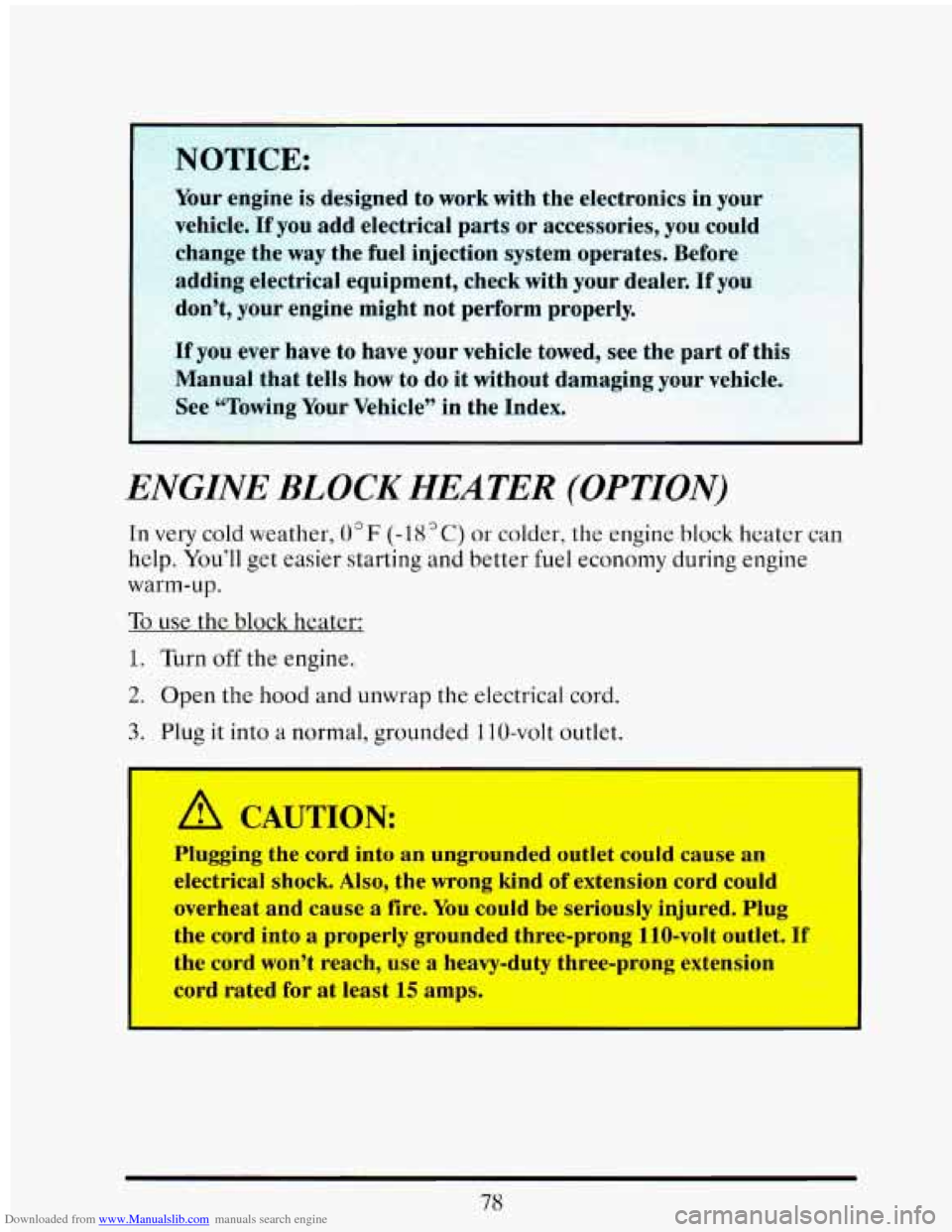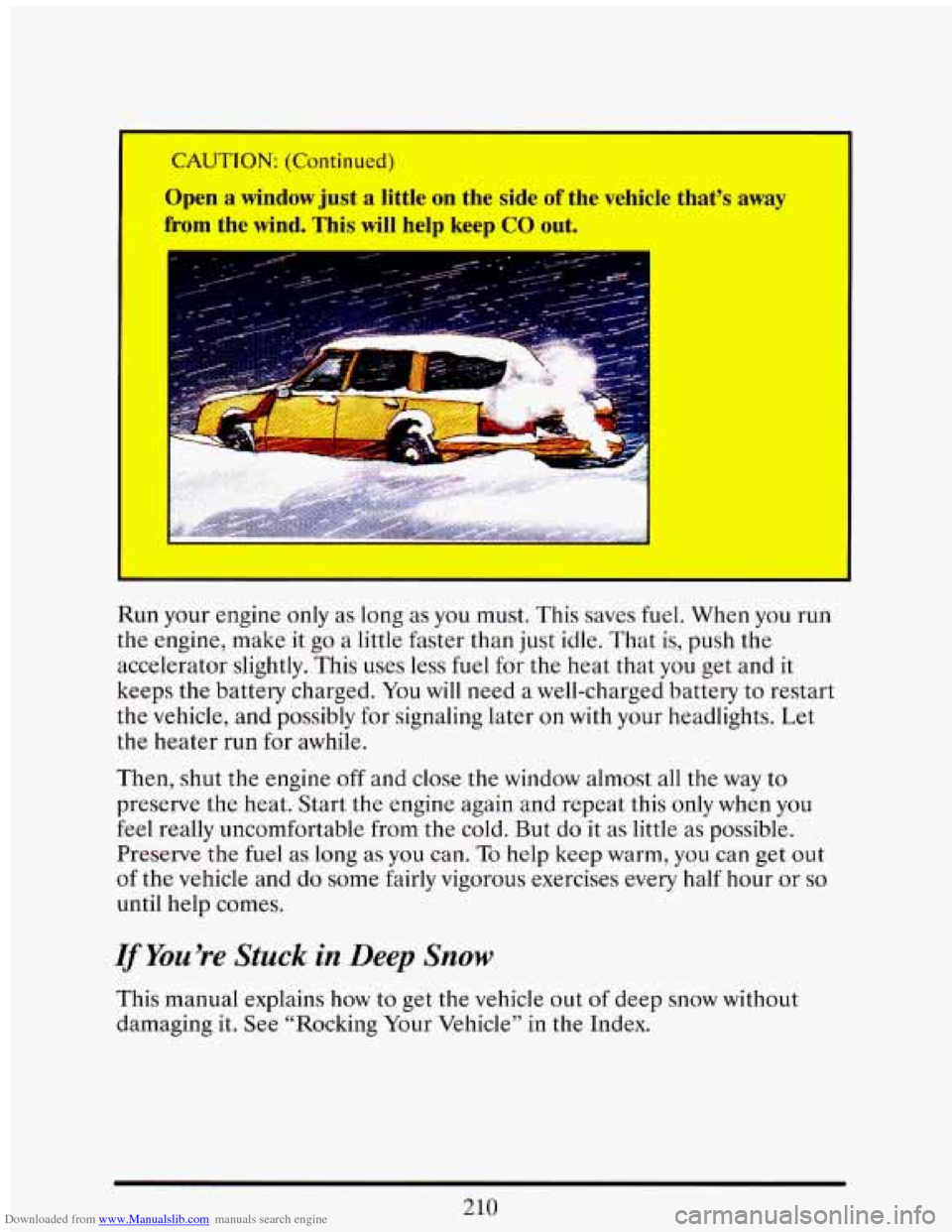Page 92 of 398

Downloaded from www.Manualslib.com manuals search engine NOTICE:
Your engine is designed to work with the electronics in yo1
vehicle. If you add electrical parts or accessories, you cod
change the
way the fuel injection system operates. Before
adding electrical equipment, check with your dealer,
If you
don’t, your engine might not perform properly.
If you ever have to have your vehicle towed, see the part of this
Manual that tells
how to do it without damaging your vehicle.
See “Tnwing Your Vehicle” in the Index.
ENGINE BLOCK HEATER (OPTION)
In very cold weather, 0” F (-1 8 C) or colder, the engine block heater can
help. You’ll get easier starting and better fuel econonly during engine
warm-up.
To use the block heater:
1. Turn off the engine.
2. Open the hood and unwrap the electrical cord.
3. Plug it into a normal, grounded 1 10-volt outlet.
r
electrical shock. Also, the wrong kind of extension cord could
the cord into
a properly grounded three-prong 110-volt outlet. If
the cord won’t reach, use a heavy-duty three-prong extension
cord rated for at least
15 amps.
I overheat and cause a fire. You could be seriously injured. Plug
78
Page 93 of 398
Downloaded from www.Manualslib.com manuals search engine ~ .- . ~. .. . -. .~ .. .
NOTICE: ~ ,. ,. .
After you’ve’.ts&d’h& bioch ~deater, be sure to store the cord as it
was before, to keep it away frop ltlcrvin 3tlgi-e marts. If you:
I don’t, it could be damaged. I
How long should you keep the
block heater plugged in? The answer
depends on the weather, the kind
of oil you have, and some other things.
Instead
of trying to list everything here, we ask that you contact a Cadillac
dealer in the area where you’ll be parking your vehicle. The dealer can
give you the best advice
for that particular area.
DRn’lNG THROUGH DEEP STANDING
WATER
NOTICE:
If you drive too quickly through deep puddles or standing water,
water can come in through your engine’s air intake and badly
damage your engine.
If you can’t avoid deep puddles or standing
water, drive through them very slowly.
79
Page 160 of 398

Downloaded from www.Manualslib.com manuals search engine (Bi-level). On bright sunny days in cold weather, the air flow could even
come out the A/C outlets
to maintain comfort.
Electronic Climate Control Features
A/C Purge
If your vehicle is sitting out on a hot day and you have it set on AUTO,
the air will first flow out the floor air ducts for a few seconds. That is
normal. This is to expel hot air in the air ducts. As the air is cooled, the
flow will move through the A/C outlets.
Cold Weather Purge
On cold days when your system is first turned on, at any setting other
than Defroster, DEFOG
or OFF a small amount of air will flow through
the defroster duct preventing your windshield from fogging.
Automatic Defog
When using your wipers or rear window defogger for several minutes, the
system senses that
a humid condition exists. When this happens air flow
will be directed to the windshield and floor ducts to keep your side glass
and windshield clear.
Manually Recirculate Inside Air
There may be times, when you don't want air from the outside. To
recirculate the air from the inside only, just set the temperature to 60°F
(16OC) and adjust your fan speed.
DEFOG
Push this button to divide the air between the Windshield and the heater
ducts. This is useful
when fog appears on the windshield or side glass due
to a sudden
rain.
146
Page 224 of 398

Downloaded from www.Manualslib.com manuals search engine Open a window just a little on the side of the vehicle that’s away
from the wind. This will help keep GO out.
Run your engine only as long as you must. This saves fuel. When you run
the engine, make it go a little faster than just idle. That is, push the
accelerator slightly. This uses less
fuel for the heat that you get and it
keeps the battery charged. You will need a well-charged battery to restart
the vehicle,
and possibly for signaling later on with your headlights. Let
the heater run for awhile.
Then, shut the engine off and close the window almost all the way to
preserve the heat. Start the engine again and repeat this only when you
feel really uncomfortable from the cold. But do
it as little as possible.
Preserve the fuel as long
as you can. To help keep warm, you can get out
of the vehicle and do some fairly vigorous exercises every half hour or so
until help comes.
VYou’re Stuck in Deep Snow
This manual explains how to get the vehicle out of deep snow without
damaging
it. See “Rocking Your Vehicle’’ in the Index.
210
Page 246 of 398
Downloaded from www.Manualslib.com manuals search engine 2. Turn on your heater to full hot at the highest fan speed and open the
window as necessary.
3. Try to keep your engine under load (in a drive gear where the engine
runs slower).
If you no longer have the overheat warning, you can drive. Just to be safe,
drive slower
for about ten minutes. If the warning doesn’t come back on,
you can drive normally.
If the warning continues, pull over, stop, and park your vehicle right
away.
If there’s still no sign of steam, you can idle the engine for two or three
minutes while you’re parked, to see
if the warning stops. But then, if you
still have the warning, TURN
OFF THE ENGINE AND GET
EVERYONE OUT OF THE VEHICLE until it cools down.
You may decide not to lift the hood but to get service help right away.
COOLING SYSTEM- 4.9 LITER
When you decide it’s safe to lift the hood, here’s what you’ll see:
Coolant recovery tank
Radiator pressure cap
Electric engine fans
232
Page 247 of 398
Downloaded from www.Manualslib.com manuals search engine I
A CAUTION:
An electric fan under the hood can start up even when the
engine is not running and can injure you. Keep hands, clothing
and tools
away from any underhood electric fan.
If the coolant inside the coolant recovery tank is boiling, don’t do
anything else until it cools down.
The coolant level should be at or above
“FULL COLD.” If it isn’t, you
may have
a leak in the radiator hoses, heater hoses, radiator, water pump
or somewhere else
in the cooling system.
I
Heater and radiator hoses, and other engine parts, can be very
hot. Don’t touch them. If you do, you can be burned.
Don’t run the engine if there is
a leak. If you run the engine, it
z;:s- could lose all coolant. That could cause an engine fire, and you
%-?7 ..- I could be burned. Get any leak fixed before you drive the vehicle.
2 . Y -- I
-
- .:.- .. .
.-I. * .C, . --
233
Page 248 of 398

Downloaded from www.Manualslib.com manuals search engine NOTICE:
Engine damage fro running: your
covered hv vow 1 rrant
wine withc bolant isn’t
If there seems to be no leak, check to see if the electric engine fans are
running. If the engine is overheating, both fans should be
running. If they
aren’t, your vehicle needs service.
How to Add Coolant to the Coolant Recovery Tank
If you haven’t found a problem yet, but the coolant level isn’t at or above
“FULL COLD,” add a 50/50 mixture of clean water (preferably distilled)
and
a proper antifreeze at the coolant recovery tank. (See “Engine
Coolant’’
in the Index for more information about the proper coolant
mix.)
,/!1 CAUTIO
Adding only plain water ur coomg syscem can De
dangerous. Plain water, or some other liquid like alcohol, can
boil before the proper coolant mix
will. Your vehicle’s coolant
warning system
is set for the proper coolant mix. With plain
water
or the wrong mix, your engine could get too hot but you
wouldn’t get the overheat warning. Your engine could catch
fir6
and you or others could be burned. Use a 50/50 mix of ( m
water I d a Droner antifreeze
I
I
NOTICE:
1
In cold weather, water can L Jeze and crack the engine, radiato,,
heater core and other parts. Use the recommended coolant.
234
Page 255 of 398
Downloaded from www.Manualslib.com manuals search engine T
I A CAUTION:
An electric fan under the hood can start up even when the
engine
is not running and can injure you. Keep hands, clothing
and tools away from any underhood electric fan.
If the coolant inside the coolant surge tank is boiling, don’t do anything
else until it cools down.
r
/1
I
r
I-
= The coolant level
~ should be at or above
“FULL COLD.” If it
isn’t, you may have a
leak in the radiator
hoses, heater hoses,
radiator, water pump
or somewhere else
in
the cooling system.
A CAUTION:
Heater and radiator hoses, and other engine parts, can be very
hot. Don’t touch them.
If you do, you can be burned.
Don’t run the engine if there is a leak.
If you run the engine, it
could lose all coolant. That could cause an engine fire, and you
could be burned. Get any leak fmed before you drive the vehicle.
241